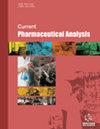Development and Validation of an Analytical RP-HPLC Method for Simultaneous Estimation of Losartan and its Active Metabolite (EXP-3174) in Isolated Perfused Rat Liver
IF 1.5
4区 医学
Q4 PHARMACOLOGY & PHARMACY
引用次数: 0
Abstract
Background:: The liver perfusion method is frequently used in drug pharmacokinetic studies and the various effects of drugs on liver tissue. The aim of this study was to establish and validate an analytical method using high-performance liquid chromatography to determine the simultaneous concentration of losartan and its active metabolite, EXP-3174, in an isolated perfused rat liver study. Method:: An HPLC system with isocratic mode was used. Various chromatographic parameters were adjusted to develop and validate a method for determination of losartan and its active metabolite in liver perfusion media. Results:: In this study, losartan and its active metabolite, EXP-3174, were separated using a C18 stationary phase, a mobile phase consisting of acetonitrile: phosphate buffer at a flow rate of 1 mL.min-1, and UV detection at 254 nm. Retention times for losartan and the metabolite were 10 and 16 minutes, respectively. Linearity from 25-250 ng.ml-1 was validated with acceptable accuracy and precision. The LOD and LOQ for losartan were 7.0 and 21.1 ng.ml-1, respectively. The LOD and LOQ for metabolite were 7.4 and 22.4 ng.ml-1, respectively. ChromGate® software was used to acquire and process the data. Conclusions:: The optimized and validated technique was effectively used to analyze losartan and its active metabolite in isolated perfused rat liver.分离灌流大鼠肝脏中洛沙坦及其活性代谢物 (EXP-3174) 的 RP-HPLC 分析方法的开发与验证
背景肝脏灌注法常用于药物药代动力学研究和药物对肝组织的各种影响研究。本研究旨在建立并验证一种高效液相色谱分析方法,用于同时测定离体灌流大鼠肝脏中洛沙坦及其活性代谢物 EXP-3174 的浓度。方法:采用等度高效液相色谱系统。通过调整各种色谱参数,开发并验证了肝脏灌注介质中洛沙坦及其活性代谢物的测定方法。结果本研究采用 C18 固定相分离洛沙坦及其活性代谢物 EXP-3174,流动相为乙腈:磷酸盐缓冲液,流速为 1 mL.min-1,紫外检测波长为 254 nm。洛沙坦和代谢物的保留时间分别为 10 分钟和 16 分钟。该方法的线性范围为 25-250 纳克/毫升,准确度和精密度均可接受。洛沙坦的 LOD 和 LOQ 分别为 7.0 和 21.1 ng.ml-1。代谢物的 LOD 和 LOQ 分别为 7.4 和 22.4 ng.ml-1。使用 ChromGate® 软件获取和处理数据。结论经过优化和验证的技术可有效分析离体灌注大鼠肝脏中的洛沙坦及其活性代谢物。
本文章由计算机程序翻译,如有差异,请以英文原文为准。
求助全文
约1分钟内获得全文
求助全文
来源期刊
CiteScore
1.50
自引率
0.00%
发文量
85
审稿时长
3 months
期刊介绍:
Aims & Scope
Current Pharmaceutical Analysis publishes expert reviews and original research articles on all the most recent advances in pharmaceutical and biomedical analysis. All aspects of the field are represented including drug analysis, analytical methodology and instrumentation. The journal is essential to all involved in pharmaceutical, biochemical and clinical analysis.

 求助内容:
求助内容: 应助结果提醒方式:
应助结果提醒方式:


